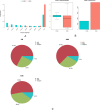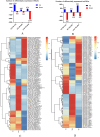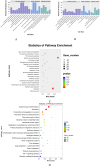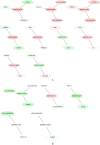Co-expression of LncRNA and mRNA in the cumulus-oocyte complex of rabbits exposed to ammonia
- PMID: 40452014
- PMCID: PMC12128280
- DOI: 10.1186/s12917-025-04806-9
Co-expression of LncRNA and mRNA in the cumulus-oocyte complex of rabbits exposed to ammonia
Abstract
Background: Ammonia (NH3) is an environmental pollutant and a potent reproductive stressor widely found in rabbit houses. Exposure to ammonia can result in follicle atresia, affect oocyte maturation and cause cumulus cell apoptosis. Long non-coding RNA (lncRNA) is an important factor in the regulation of cumulus cell development and oocyte maturation. The potential molecular mechanism of NH3 in the induction of cumulus-oocyte complex (COCs) toxicity and the regulatory role of lncRNA in COCs are currently unclear.
Methods: A total of 150 female IRA rabbits (35 days old) were randomly divided into three groups, and kept in environmental control rooms for four weeks. The rabbits in the control group (CG) were kept under an NH3 concentration of < 3 ppm. The two treatment groups were kept under NH3 concentrations of 10 ppm (low ammonia concentration, LAC) and 30 ppm (high ammonia concentration, HAC). We used a combination of RNA deep sequencing, quantitative real-time polymerase chain reaction (qRT-PCR), and bioinformatic analysis to explore the regulatory mechanism of lncRNA and messenger RNA (mRNA) in COCs.
Results: We found that primordial follicles and primary follicles were significantly decreased while atretic follicles were significantly increased in the NH3-treated groups. The results from Gene Ontology (GO) items showed that female meiosis sister chromatid cohesion and the regulation of follicle-stimulating hormone secretion were involved in the mechanism of rabbits exposed to NH3. The results demonstrated that the mammalian target of the rapamycin (mTOR) signaling pathway and the transforming growth factor-beta (TGF-beta) signaling pathway inhibits germ cell development and follicular growth in the LAC versus the CG group. LncRNAs were involved in the apoptosis of female germ cells via the hypoxia-inducible factor (HIF-1) signaling pathway in the HAC versus the CG group. Co-expression analysis found that lncRNA MAPK3 and lncRNA SHC1 were correlated with changes in cumulus cell and oocyte function after NH3 exposure.
Conclusions: These results indicate that NH3 affected the development and function of COCs by influencing lncRNA expression.
Keywords: Ammonia; Cumulus-oocyte complex; LncRNA; Rabbit; Reproductive dysfunction.
© 2025. The Author(s).
Conflict of interest statement
Declarations. Ethics approval and consent to participate: All experiments were performed in accordance with the ARRIVE guidelines and were carried out in accordance with the U.K. Animals (Scientific Procedures) Act, 1986 and associated guidelines, EU Directive 2010/63/EU for animal experiments, and the National Institutes of Health guide for the care and use of Laboratory animals (NIH Publications No. 8023, revised 1978), approved by the Ethics Committee of Animal Experimentation of Hebei Agricultural University (Protocol 2021083) and obtained informed consent from Xingtai Kangming Breeding Co., LTD (Xingtai, China) to use the animals. Consent for publication: Not applicable. Competing interests: The authors declare no competing interests.
Figures






References
-
- Cui J, Wu F, Yang X, Liu S, Han S, Chen B. Effects of ammonia on hypothalamic-pituitary-ovarian axis in female rabbits. Ecotoxicol Environ Saf. (2021) Dec 20;227:112922. doi: 10. 1016/j.ecoenv.2021.112922. - PubMed
-
- Xu Y, Li Z, Zhang S, Zhang H, Teng X. miR- 187-5p/apaf- 1 axis was involved in oxidative stress-mediated apoptosis caused by ammonia via mitochondrial pathway in chicken livers. Toxicol Appl Pharmacol. (2020)Feb 1;388:114869. doi: 10. 1016/j.taap.2019.114869. - PubMed
MeSH terms
Substances
Grants and funding
LinkOut - more resources
Full Text Sources
Miscellaneous

